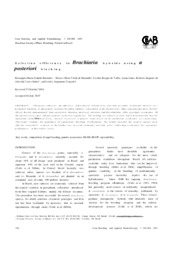Selection efficiency in Brachiaria hybrids using a posteriori blocking.
Selection efficiency in Brachiaria hybrids using a posteriori blocking.
Author(s): RESENDE, R. M. S.; RESENDE, M. D. V. de; VALLE, C. B. do; JANK, L.; TORRES JÚNIOR, R. A. de A.; CANÇADO, L. J.
Summary: This paper compares the efficiency of Brachiaria hybrid clone selection by either traditional analysis or a posteriori blocking, to adequately consider the effect oflower competition in the border rows ofthe experimental plots (border effect). Results demonstrated that a posteriori blocking improved selection and the reliability ofthe genotypic evaluation. Of the ten best clones. four did not coincide in the two approaches. The ranking was altered as well, which demonstrated that the indication of the five best clones. selected to proceed to pasture trials based on the traditional evaluation, was misleading. This paper confirms the usefulness of a posteriori blocking. Furthermore, the results revealed lhe need to impose more effective competition on plants in the border rows to avoid erroneous selection when conducting evaluations for agronomic performance in Brachiaria trials.
Publication year: 2007
Types of publication: Journal article
Unit: Embrapa Forestry
Keywords: Brachiaria, Competição, Gramínea, Parâmetro Genético, REML-BLUP, Repetibilidade
Observation
Some of Embrapa's publications are published as ePub files. To read them, use or download one of the following free software options to your computer or mobile device. Android: Google Play Books; IOS: iBooks; Windows and Linux: Calibre.
Access other publications
Access the Agricultural Research Database (BDPA) to consult Embrapa's full library collection and records.
Visit Embrapa Bookstore to purchase books and other publications sold by Embrapa.

